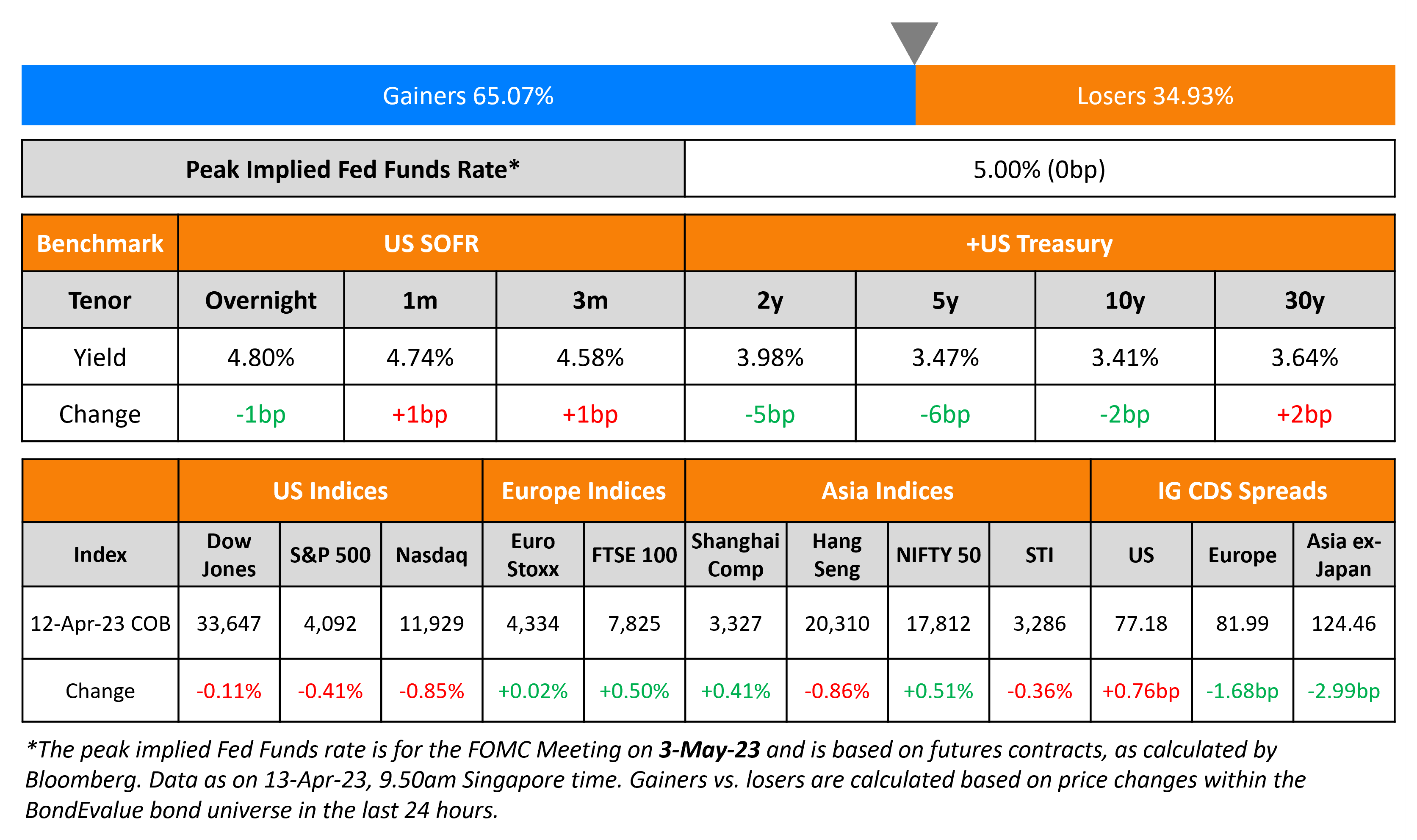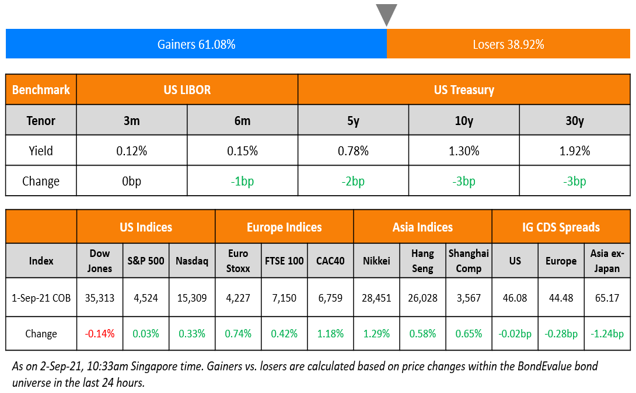This site uses cookies to provide you with a great user experience. By using BondbloX, you accept our use of cookies.
Bond Market News
US CPI at 5%, Core CPI at 5.6%; Macro; Rating Changes; New Issues; Talking Heads; Gainers and Losers
April 13, 2023

US Treasury yields dipped slightly by ~3-5bp following the CPI and FOMC minutes. US CPI came at 5% for March 2023, below expectations of 5.1% and lower than last month’s 6% print. Core CPI came at 5.6%, in-line with the surveyed 5.6% and higher than last month’s 5.5% print. The policy-sensitive 2Y fell below 4% again to 3.98% while the peak Fed funds remained unchanged at 5%. Similarly, the probability of a 25bp rate hike in the May meeting stayed unchanged at 71% as per the CME’s maximum probabilities.
The FOMC’s March meeting minutes, also released yesterday, showed that Fed officials decided on the rate hike despite the failure of SVB and Signature Bank as inflationary pressures were still strong. Besides, officials appeared on track for a hike at the May meeting. The Fed projects a mild recession later this year and a recovery in the subsequent two years. US IG and HY CDS spreads widened 0.8bp and 5.9bp respectively. US equity indices ended lower with the S&P and Nasdaq 0.4% and 0.9% lower.
European equity markets ended slightly higher. European main CDS spreads tightened by 1.7bbp and Crossover spreads were 8.5bp tighter. Asia ex-Japan CDS spreads tightened by 3bp. Asian equity markets have broadly mixed this morning.
Happening Today: 2-hour Course on Bonds for Individual Investors
New Bond Issues
- Nickel Industries $ 5.5NC2.5 at 11.5% area

Santander raised €750mn via a 5Y covered bond at a yield of 3.481%, 2bp inside initial guidance of MS+45bp area. The bonds have expected ratings of Aa2/AA-.
Walmart raised $5bn via a five-tranche issuance. It raised:
- $750mn via a 3Y bond at a yield of 4.016%, ~37.5bp inside initial guidance of T+65bp area.
- $750mn via a 5Y bond at a yield of 3.941%, ~37.5bp inside initial guidance of T+80bp area.
- $500mn via a 7Y bond at a yield of 4.032%, ~27.5bp inside initial guidance of T+90bp area. The new bonds are priced 14.2bp wider to its older 1.8% 2031s that yield 3.89%.
- $1.5bn via a 10Y bond at a yield of 4.1%, ~27.5bp inside initial guidance of T+100bp area.
- $1.5bn via a 30Y bond at a yield of 4.517%, ~37.5bp inside initial guidance of T+125bp area. The new bonds are priced 4.7bp wider to its older 4.5% 2052s that yield 4.47%.
The bonds have expected ratings of Aa2/AA/AA. Proceeds will be used for general corporate purposes.
New Bonds Pipeline
- Korea Ocean Business hires for $ bonds
- Commerzbank hires for € 6Y Covered bond
- Kookmin Bank hires for $ 3Y and/or 5Y bond
Rating Changes
Term of the Day
Prepaid Forward Contracts
Prepaid Forward Contracts are predominantly used by investors who hold a large number of shares in a single firm. It allows these investors to pledge the sale of a certain amount of the shares that they hold, on a future date. Furthermore, instead of waiting for the future date to receive the proceeds of its sale, investors will receive prepayments on their stock sale upfront. These prepayments are akin to a tax-free deposit since the tax liabilities on the capital gains are not due until the transaction is settled on the future date. Additionally, these contracts give investors the possibility of holding on to more shares than the amount that they committed.
For example, Party A pledges $1mn of shares that are currently priced at $10 each. This amounts to 100,000 shares now. If the price drops below $10 in the future, Party A will still have to deliver 100,000 shares on the delivery date. However, if the price rises to $20 for example, Party A will only have to deliver 50,000 shares ($1mn divided by $20) on the future delivery date.
Talking Heads
On Traders Boosting Bets on Fed Rate Cuts by Year-End After CPI
Priya Misra, global head of rates strategy at TD Securities
“Inflation is still high, but it has peaked and if shelter is turning, some of the pressure on the Fed to keep hiking will decline”
Andrew Patterson, senior economist at Vanguard Group
“Yields have been more than a bit volatile recently. Focusing on market pricing is helpful but doesn’t present the whole story. And today’s data shows core inflation actually picking up this month on a year-on-year basis and that says to us that the Fed still has more work to do”
Jay Bryson, chief economist at Wells Fargo
“If we have a soft landing, I could see the inflation rate getting stuck at 3 to 3.5%… I have a bit of a disagreement with where the 2-year yield is right now”
On Goldman Sachs not expecting Fed rate hike in June anymore
Goldman Sachs economists
“We have taken out the June hike in part because the limited data available so far appear to confirm that credit is indeed somewhat tight in the aftermath of the banking turmoil, and in part because some Fed officials appear hesitant about even a May hike”
BofA economists
“Despite the improvement in March, inflation is still likely much too high from the Fed’s perspective”
On US and China Sending Global Debt to Record – IMF
IMF Fiscal Affairs Department Director Vitor Gaspar
“Going forward, public debt is not only elevated higher than what was projected before the pandemic, it’s also increasing faster than what was projected before the pandemic. You need to rebuild fiscal buffers, because you need to be in a position to face adverse developments, be it economic or financial”
Top Gainers & Losers –13-April-23*
Go back to Latest bond Market News
Related Posts:.png)










